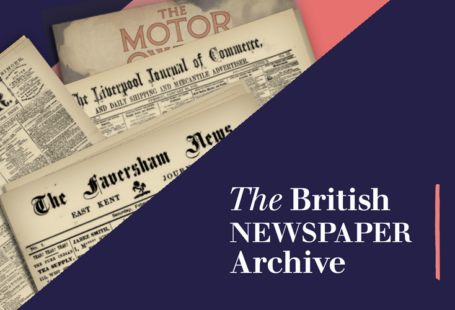At the British Newspaper Archive, we have started to digitize international newspapers from the British Library. These rich titles explore the story of the British Commonwealth, from the time when the sun didn’t set on the British Empire through to states gaining their independence. At times, the subject of the newspapers brings us face to face with the stark and sometimes inhuman reality of colonialism and the legacy of the British Empire across the world.
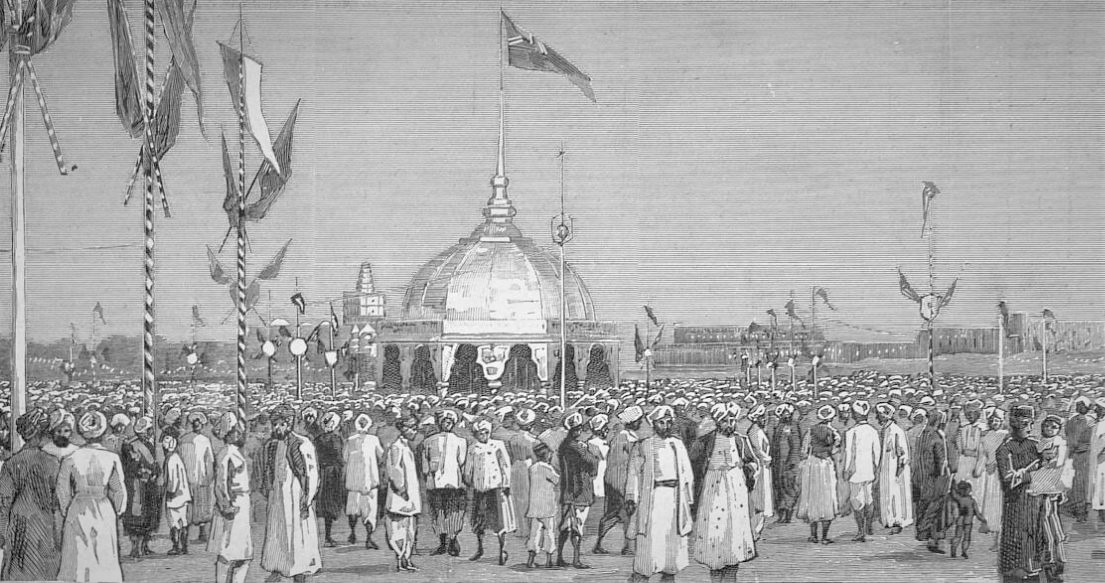
Below we will explore some of the new international titles available at The British Newspaper Archive. Most of the newspapers were written by and published for the British population living in the colonies. They cover a range of topics including international politics, military campaigns, civil service appointments as well as domestic occurrences such as births, marriages, and deaths.
Register now and explore The Archive
Caribbean
Belize
We start our journey in Belize with the Colonial Guardian . The Guardian was published in Belize City from 1882 to 1913. At the time, Belize was known as British Honduras. The country had been first colonised by the Spanish conquistadors and then by the English. The first English settlement was established in 1716.
What is unique about the Colonial Guardian is that the publishers tried to create a newspaper that could be read by both the British and the natives so they translated many of their articles into Spanish too. The editors express that they wanted the newspaper to help the colony on the path to progress and invited contributions from the public, particularly about agricultural development. The first issue details the history of agriculture and the logwood and mahogany trade of Belize.
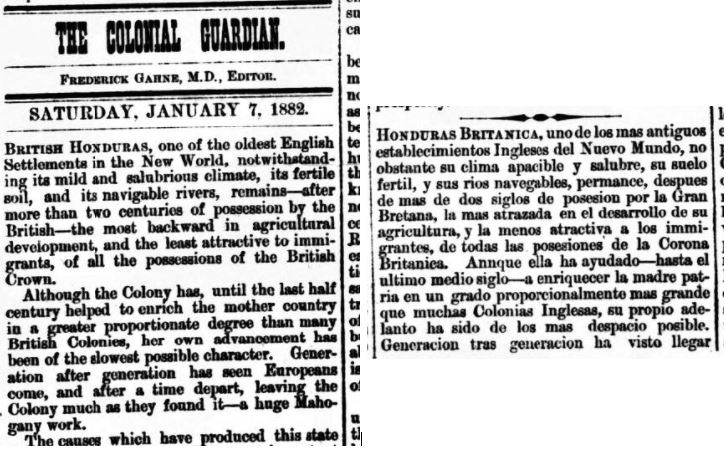
Jamaica
Jamaica became a British colony in 1655 until it achieved independence in 1962. 1779 saw the debut of The Jamaica Mercury which later became The Royal Gazette of Jamaica. The first issue was not filled with testimony of progress or native languages, instead, it started with a look at world affairs and international politics from Germany, France and Russia.
‘The situation of public affairs in Europe is not becoming no less interesting than alarming. The Bavarian succession has already drawn forth the armies of Austria and Prussia….The Empress of Russia has declared her revolution to support the rights of the Germanic…. Should Spain be drawn into this war with Great Britain, which France has so unjustly commenced.’
The Graphic brings us illustrations of colonial life in Jamaica in the 19th century.


The British planters exploited the land and the Caribbean climate to grow sugarcane. Jamaica became the largest exporter of sugarcane. Sugarcane production was labour intensive and the planters also exploited the local population by enslaving thousands of native Jamaicans and Africans to work on vast and lucrative sugar estates. By the time the first issue of The Jamaica Mercury went to print the number of enslaved Jamaicans exceeded 200,000.
The advertisements focused on identifying and capturing runaway slaves brings us face to face with the brutal reality of the life of the enslaved people of Jamaica. The advertisements describe the awful brandings that were burned into the flesh to identified the enslaver.

The slave trade was abolished in 1834, but the adjustment in Jamaica was not without conflict and hardship as can be seen in this article emphasizing the point that even though the former slaves were ‘apprentices’ that their behaviour could still render them liable for punishment.
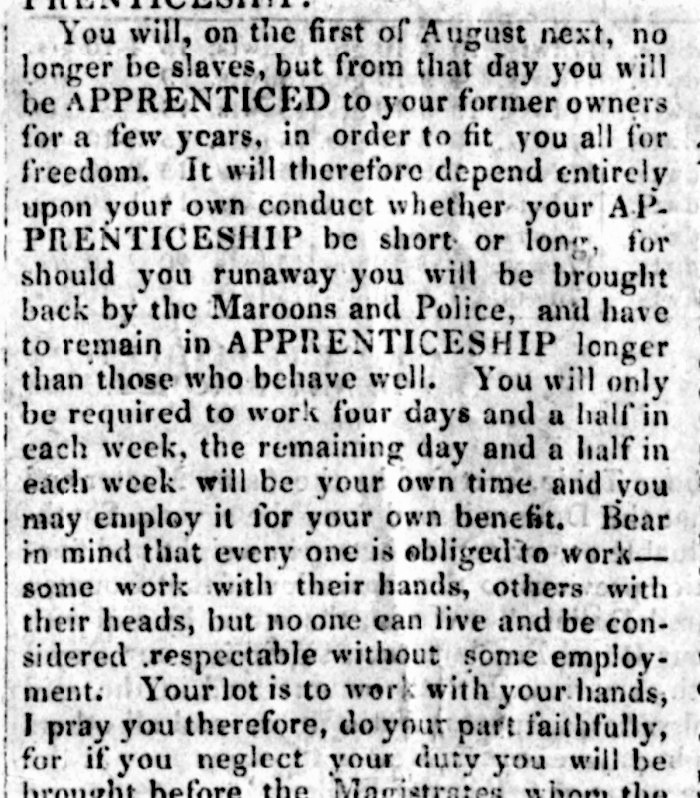
You can explore more of the history of the British in Jamaica with over 16,000 pages of The Royal Gazette of Jamaica to read.
Another of our Jamaican titles is the Morning Journal (Kingston). This newspaper was published on the 31 October 1838, some four years after the Abolition of Slavery Act was finally enforced. It takes a moment in its first edition to reflect on ‘The most important event in the annals of Colonial history,’ which took place on 1 August 1834, the day that Emancipation took place. Emancipation Day, 1 August, is now a holiday in Jamaica, and marks the beginning of a week of special cultural celebrations.
Life in post-emancipation Jamaica is further chronicled in the newspaper Budget (Jamaica). A tri-weekly publication, it contained all the news from the island, painting a vivid picture of life in Jamaica during the 1870s and 1880s. Within its pages you can find items like ship departures and arrivals, advertisements for groceries and ships to charter, what was on at the Theatre Royal, as well as news from further afield.
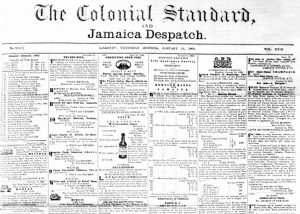
Likewise painting a vivid picture of life in Jamaica in the second half of the nineteenth century is the Colonial Standard. This title was founded in Kingston in the early nineteenth century, and was sent back to the United Kingdom with all the news from the island. In the 1870s it was said of the Colonial Standard that was the ‘leader of the Jamaica press,’ and that its ‘extent and variety of the news and information in it causes it be sought with eagerness by every class in the Island.’
Saint Kitts and Nevis
Becoming a part of the British Empire in 1793, the dual island nation of Saint Kitts and Nevis, which lies between the Atlantic Ocean and the Caribbean Sea, was long fought over by French, Spanish and British forces. Indeed, forts still scar the landscape telling of the islands’ past as a centre of conflict.
Like Jamaica, the land of Saint Kitts and Nevis was used to grow sugarcane, and enslaved Africans were brought to the islands to work on plantations from 1640 onwards, undertaking this grueling and back-breaking work.
 Providing chilling evidence of this slave-based economy was early Kittian newspaper the St. Christopher Gazette, which was first published as early as 1771. In these pages you will find disturbing references to the sale of enslaved people, including one such sale of ‘160 Prime Young Gold Coast Slaves’ to be held on 21 February 1771.
Providing chilling evidence of this slave-based economy was early Kittian newspaper the St. Christopher Gazette, which was first published as early as 1771. In these pages you will find disturbing references to the sale of enslaved people, including one such sale of ‘160 Prime Young Gold Coast Slaves’ to be held on 21 February 1771.
Underlying how these enslaved people were regarded purely as property, rather than human beings, are the notices you will also find to those captives who had been ‘Taken Up,’ like Tom:
‘Taken up – a…man who says his name is Tom, and that he belongs to Mr. Akers. He is about five feet five inches high, and is a stout well made fellow. The owner may have him delivered on paying the customary fees the law directs…’
Also contained on The Archive are editions of the St. Christopher’s Gazette published after the eventual emancipation of Saint Kitts and Nevis’s enslaved population. By then, the newspaper had become the St. Christopher Gazette, and Caribbean Chronicle, with a focus on reporting news from across the Caribbean, alongside the local news of quarter sessions and the latest bankruptcies.
Saint Kitts pictured in 1951 | The Sphere | 27 January 1951
A rival to the St. Christopher Gazette was the Saint Christopher Advertiser and Weekly Intelligencer. This newspaper was first published in 1782 or 1783, just as Saint Kitts and Nevis became affiliated with Britain. But there was something a little different about the Saint Christopher Advertiser and Weekly Intelligencer. Namely, it was run by a Black family, the Cables, which was highly unusual in the Caribbean at the time.
Edited by the activist Samuel Cable from 1829 to his death in 1839, it gained popularity with the ‘freed’ population of the islands, eclipsing its rival the St. Christopher Gazette. Staying in the Cable family, the newspaper promised to advocate its ‘countrymen’s welfare,’ and it continued to be published until approximately 1908.
Another newspaper owned by the pioneering Cable family was the St. Kitts Daily Express. Consisting of one sheet, it promised to be ‘A Periodical for the Homes of the People’ and first appeared on the 30 September 1884.
Consisting of one sheet, it promised to be ‘A Periodical for the Homes of the People’ and first appeared on the 30 September 1884.
Run by Richard Cable, who also edited the Saint Christopher Advertiser and Weekly Intelligencer, it ran with this line from John Milton – ‘Give me the liberty to know, to utter, and to argue freely’ – which surely meant all to a nation whose population had been enslaved some fifty years before.
St. Kitts Daily Express | 13 March 1886
Saint Lucia
Located in the Windward Islands, French colonialists first signed a treaty with the native Island Caribs of Saint Lucia in 1660, but the island was taken over by the British only three years later. With France and Britain in constant conflict, the rule of the island changed constantly until 1814, when Britain took control of Saint Lucia for the final time.

During the occupation of Saint Lucia by both the French and British, enslaved peoples were brought to the island to work on sugar plantations. Following the French Revolution, enslavement was abolished briefly in 1794 when Saint Lucia was under French control, but when the island was retaken by the British enslavement was re-established. Enslavement was finally brought to an end in the Caribbean in 1834.
An interesting fact – the island of Saint Lucia is only one of two countries to be named after a woman, having been named after Saint Lucy of Syracuse, the other country being Ireland (named after the goddess Eire).
And available on The Archive is the national newspaper of the island, the Voice of St. Lucia.

Founded in Castries, the island’s capital, in January 1885, the newspaper was established by Irishman Robert George McHugh. Published once a week, and filling four pages with shipping intelligence, news of departures and arrivals, and local notes, the Voice of St. Lucia is still running to this day.
Indeed, as one of the oldest continuously published newspapers in the Caribbean, the Voice of St. Lucia is one of the oldest newspapers in the Eastern Caribbean.
Barbados
The island of Barbados was claimed for the British in 1625, and in 1627 it became a British colony. Initial British colonization of Barbados saw a large number of Irish indentured servants and other involuntary transported people amongst its early population, but with the introduction of the sugar cane revolution to Barbados in 1640 the island became the English centre of the trade of enslaved Africans.
Post-emancipation Barbados – a fish market | The Graphic | 27 February 1897
In 1644 there were 800 enslaved Africans in Barbados; by 1660 there were 27,000. The enslavers of Barbados had a particularly brutal reputation, as the island grew rich off the profits of the sugar farmed by its enslaved people.
 Emancipation eventually came to Barbados in 1834. And on 15 January 1845 the Barbados Agricultural Reporter was first published in the Barbadian capital of Bridgetown, priced at 25 cents. To give it its full title, this periodical was known as the Barbados Agricultural Reporter and Planter’s Scientific Journal, running with the bi-line ‘Science with Practice.’
Emancipation eventually came to Barbados in 1834. And on 15 January 1845 the Barbados Agricultural Reporter was first published in the Barbadian capital of Bridgetown, priced at 25 cents. To give it its full title, this periodical was known as the Barbados Agricultural Reporter and Planter’s Scientific Journal, running with the bi-line ‘Science with Practice.’
It lays out its mission in the publishing world, stating how the ‘altered relations of society’ had made it ‘desirable’ for such a publication focusing on agriculture. The ‘altered relations of society’ referred to here are the effects of Emancipation, as this title would have been targeted at the former enslavers who now could not rely on enslaved labour.
So, the Barbados Agricultural Reporter promised to offer ‘succinct descriptions of new agricultural machines…details of experiments with soils and planting…[and] experiments in the manner of sugar and rum,’ now that society had finally been rid of the awful stain of slavery.
Antigua
The island of Antigua was named after an icon in Seville Cathedral – Santa Maria de la Antigua – by Christopher Columbus in 1493. Over one hundred years in 1632 later British colonialists would arrive in Antigua from St. Kitt’s to form a new colony, its profits based on sugar.
Becoming known as Britain’s ‘Gateway to the Caribbean,’ slavery became common in Antigua from 1674 onwards, as early enslaver Christopher Codrington began to build his plantation, Betty’s Hope. The back-breaking work required was undertaken by enslaved people from West Africa; in 1713 there were 12,500 enslaved people forced to work in Antigua, whilst by 1770 there were 37,500.
Engraving of Antigua from 1827 | Illustrated London News | 1 April 1976
Resistance to the inhumanity and horror of slavery was enacted by enslaved man Hercules in 1729; however, he was hung, drawn and quartered for his part in a conspiracy to kill a family of enslavers. Meanwhile, similarly enslaved Prince Klaas was executed in 1736 by being broken upon the wheel for reputedly planning a rebellion.
When Emancipation eventually came in 1834, Antigua stood out from other Caribbean islands by liberating 32,000 of the island’s souls at the earliest possible opportunity – midnight, 1 August 1834.
A cottage at Gray’s Hill, Antigua, after a recent hurricane | The Sketch | 20 September 1899
We have two Antiguan newspapers currently available to search on The Archive, which chronicle post-emancipation life on the island. The first of these two newspapers is the Antigua Observer, a lively newspaper which was printed and published by Frederick S. Jewett in the Antiguan capital St John’s. Appearing every week, it contained a selection of poetry and correspondence, as well as advertisements, which the publishers complained rather ‘crowded out’ the packet news.
 Our second newspaper from Antigua is the Sun (Antigua). Claiming to be the ‘Largest Daily Paper in the Leeward Islands,’ it also promised to be the area’s best ‘advertising medium.’ Indeed, the Sun contained many richly illustrated advertisements, as well as telegrams from abroad and sport results. You can also find within its pages the names of passengers arriving in and departing from Antigua.
Our second newspaper from Antigua is the Sun (Antigua). Claiming to be the ‘Largest Daily Paper in the Leeward Islands,’ it also promised to be the area’s best ‘advertising medium.’ Indeed, the Sun contained many richly illustrated advertisements, as well as telegrams from abroad and sport results. You can also find within its pages the names of passengers arriving in and departing from Antigua.
Sun (Antigua) | 13 January 1912
Trinidad and Tobago
The most southerly island country in the Caribbean, and consisting of the main islands of Trinidad and Tobago, as well as other smaller islands, Trinidad and Tobago fell under British rule in 1802 and were unified in 1889. Trinidad had been colonised by the Spanish following the arrival of Christopher Columbus on the island in 1498, before it was finally surrendered to a British fleet in 1797. Tobago, meanwhile, had been ruled variously by the Spanish, British, French and Dutch colonists before 1802.

The first British governor of Trinidad, Thomas Picton, was notorious for his cruelty, using torture and arbitrary arrests, although he was recalled to Britain. After this point, Trinidad became a point of emigration for British, Irish, German and Italian families, whilst the islands were home to an enslaved population. Following emancipation, indentured workers were brought to the islands to replaced the enslaved workforce, from India, China and Portugal, with contracts lasting for five years at a time, and incredibly low daily wages.
Trinidad and Tobago obtained independence from Britain in 1962, and became a republic in 1976.
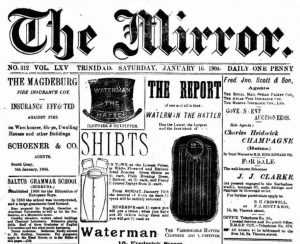
The Archive is home to the Mirror (Trinidad & Tobago), which was first published in the capital of the Port of Spain on 1 January 1898. The Mirror was edited by R.R. Mole, who had experience of journalism in Britain, with its chief reporter being H.D. Carruthers, who was known as one of the Caribbean’s best reporters.
Published twice a week, the Mirror was an independent publication, tied to no particular political interest, religion, or industry. It published news from across the world, shipping intelligence, and news from the police courts, as well as a section entitled ‘Trinidad Day By Day.’
Dominica
Part of the Windward Islands, Dominica was colonized by France between the 1690s and 1763, who established coffee plantations and introduced slavery to the island. Following the conquest of Dominique, as it was known in French, by Andrew Rollo in 1761 and the end of the Seven Years War, control of the island was then ceded to Britain in 1763.
Despite several French attempts to retake Dominica, it remained in British hands. The British continued to bring enslaved peoples to the island to work the coffee and sugar plantations, one of the largest of these being the Hillsborough Estate.
Lime picking in the Roseau Valley, Dominica | Illustrated London News | 3 June 1899
Following Emancipation in 1835, Dominica was something of a trailblazer for those of African descent. In 1835, three men of African descent were elected to the legislative assembly of Dominica. Indeed, enslaved people from Martinique and Guadeloupe fled to Dominica to regain their freedom.
By 1838, Dominica was the first colony of the British West Indies to have an elected legislature governed by an African descent majority. Sadly, this pioneering equality was not to last, as by 1865 the Colonial Office appointed half of the legislature themselves.
However, many Dominicans were to fight for Britain in the First and Second World Wars, and the island finally gained its independence on 3 November 1998.
 We currently have three newspaper from Dominica available to search on The Archive – the Dominica Dial. First published on 6 January 1883 by publisher William Davies in the capital of Roseau, it featured news from Dominica and around the Caribbean, complete with correspondence and telegrams featuring news from abroad.
We currently have three newspaper from Dominica available to search on The Archive – the Dominica Dial. First published on 6 January 1883 by publisher William Davies in the capital of Roseau, it featured news from Dominica and around the Caribbean, complete with correspondence and telegrams featuring news from abroad.
Meanwhile, pioneering Dominican editor Joseph Hilton Steber headed up the Dominica Guardian, which was established in 1893 after Steber became fed up with the conservatism of the Dominican newspaper, where he previously worked. Steber was described as a ‘fearless man with an unbridled pen, and he ran the newspaper for another 25 years. The Dominica Guardian contained a lengthy editorial section, as well as telegrams from across the world, and a look at events in Dominica.

The final of our trio of Dominican titles is the Dominica Chronicle, which is now known simply as the Chronicle. A ‘Dominican tradition since 1909,’ this newspaper was founded by Belgian Roman Catholic Bishop Philip Schelfhaut (1850-1921) and is known as the national newspaper of Dominica. With a special focus on local life, within the Dominica Chronicle you can find wonderful accounts of weddings, as well as names of those travelling to and from the island.
North America
Canada
Next, we travel north to Canada where we bring you three newspapers from another member of the British Commonwealth. First, we have Ontario’s Hamilton Daily Times not to be confused with The Hamilton Advertiser which served Glasgow and the surrounding area.
 Hint
Hint
How do you know where the title came from? Check the front page, usually below the name of the newspaper title they explain what areas they serve.
The Archive also holds two titles from Toronto. The Toronto Daily Mail was founded by Toronto’s postmaster, Thomas Charles Patterson. This conservative title was first published in 1881.
Toronto Saturday Night was a weekly magazine published in newspaper format. The front page usually begins with ‘About Town’ imparting on the reader the latest tales of the who’s who of Toronto’s high society. In this example, Rose Coghlan graces the front page and we are told that despite obstacles and hardships became one of the leading ladies of the English theatres. She later travelled to America and became a favourite. She is described as

‘Cultured and refined, a conversationalist of rare powers, a student and artists of refined instincts, and with a host of eminent friends, she is indeed a fortunate woman as well as a brilliant actress.’
Toronto Saturday Night | 27 October 1888
Finally, The Archive also holds one title from Canada’s capital city of Ottawa, the Ottawa Free Press, which was founded in 1869. A ‘Liberal and Reform Journal,’ the Ottawa Free Press was founded just two years after the Dominion of Canada was established as a self-governing entity within the British Empire. The Ottawa Free Press stood firmly in favour of Canadian Home Rule, and was dubbed a ‘stout Reform journal’ by fellow Canadian title the Toronto Daily Mail.
United States of America

Although not a part of the British Commonwealth, parts of the United States of America were once, of course, under British rule, until the ratifying of the Declaration of Independence on 4 July 1776. This declared that the Thirteen Colonies were no longer subject to the rule of King George III, and the newly independent country adopted the name of the United States of America later that year, in September 1776.
And tracing the early politics of the new nation is early American newspaper the Gazette of the United States, which was first published by John Fenno (1751-1798) in New York on 15 April 1789. Supportive of the Federalist Party, the Gazette of the United States was considered to be a semi-official organ of government.

Filling four pages, the early American newspaper reported on news from across the United States, as well as containing political essays authored by the likes of John Adams and Alexander Hamilton.
When the American capital moved to Philadelphia in 1790, the Gazette of the United States moved with it, and during the 1790s it saw competition through the likes of the National Gazette and the Philadelphia Aurora. When its founded John Fenno succumbed to an outbreak of yellow fever in 1798, control of the newspaper passed between various figures, with its final edition appearing on 7 March 1818.
India – British Raj
The Indian subcontinent was ruled by Britain for nearly 100 years 1858 to 1947. In the 18th century power in India had been consolidated by the East India Company until the formal rule was transfer to the British Crown in 1858.
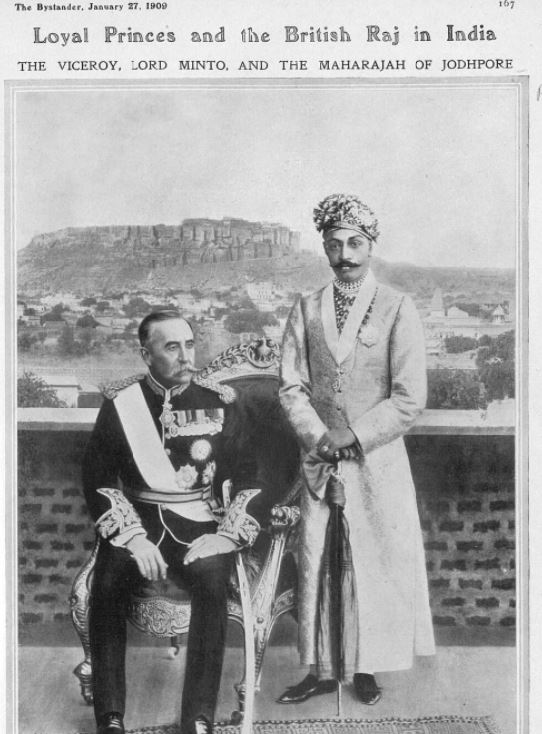
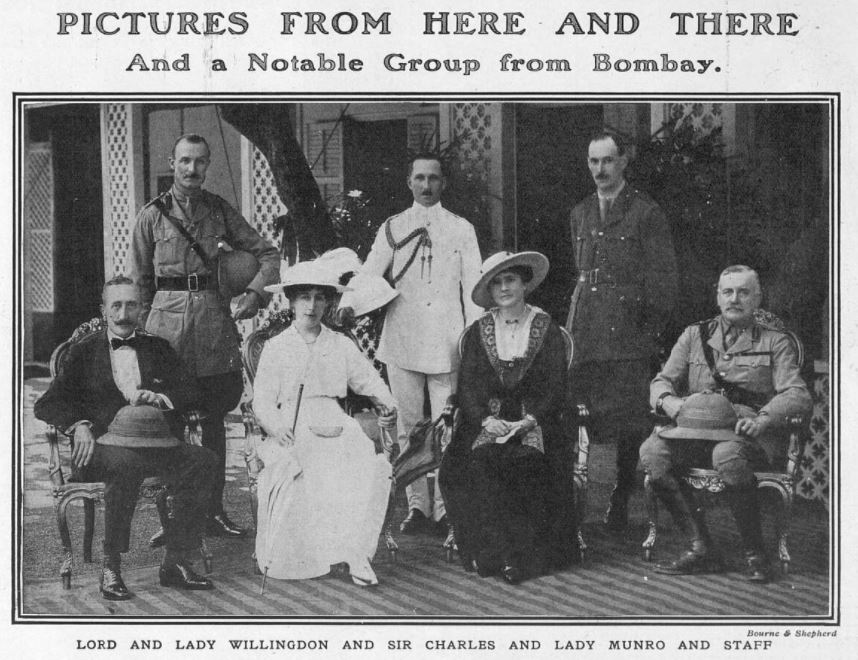
The Archive brings you numerous titles from the subcontinent, with the earliest being the Madras Courier . Like many of the British India newspapers, it focused on proceedings of the state and the civil service departments. Today Madras is known as Chennai and is the capital of the state of Tamil Nadu.
Other titles include the Indian Daily News published in Calcutta, West Bengal; the Bangalore Spectator published in Bangalore, Karnataka; and Times of India published by The Times Group in Bombay, Maharashtra.
Meanwhile, the Englishman’s Overland Mail has over 62,000 pages to read stretching from 1864 to 1928. The first issue opens with new of the money market, opium sales and the arrival of the new viceroy, Sir John Lawrence. Each front page contains a list of contents to help you jump straight into local intelligence, medical reports and shipping intelligence.
Within the Indian titles, you will find some dated and offensive language; such as calling native labourers coolies. These labourers were often used for tea cultivation on the tea plantations of Assam. After the abolition of slavery, many were forced into systems of indentured servitude.
This article discusses a recent Act of Parliament suggesting the change from payment for work completed to a fixed rate. It argues that planters would end up paying labourers even if they are lazy while those who could have completed double the amount of work will lose out on high rates of pay. The Act would also limit contracts to three years, defining the minimum pay, no work on Sunday or no more than six hours, no more than nine hours on the other six days of the week.


In 1835, a Baptist missionary, William Carey, started The Friend of India. Later the newspaper was purchased by Robert Knight who already owned The Statesman. In 1883, Knight combined the two newspapers and it became The Friend of India and Statesmen. It was a large, weekly title producing 16 pages each week. It brought news of municipal affairs, changes in the law and domestic occurrences like in this article from 1852 (insert left).
This title continues to be published today as The Statesman, having absorbed The Englishman (previously known as the Englishman’s Overland Mail) in 1927. Now adopting a centre-right perspective, The Statesman famously went against British government censorship in 1943 to publish pictures of the devastating Bengal famine.
Our next Indian title is the Bombay Gazette, first published in 1792 in Bombay, which now known as Mumbai. It was Bombay’s first English-language newspaper and the city’s leading newspaper for many years, it traces Bombay’s (now known as Mumbai) development into an important trading post. It contained local interest articles regarding Bombay, obituaries of British residents, as well as birth and marriage notices. In addition to this, it carried advertisements for a plethora of local services (including dentists) and products, like the latest fashions for the ‘ladies of Bombay.’
‘General View of Bombay’ | Illustrated London News | 4 June 1853
By the 1860s, the Bombay Gazette was being published daily, and was ‘circulated throughout the Presidency, British India, and the East.’ You can search nearly 40,000 pages of this title on The Archive, covering the years 1792 to 1868.
Another title to be published in what was formerly known as Bombay was the Voice of India. Established in 1883, it was different to other Indian English-language newspapers of the time, as it was founded not by a member of the British Raj, but renowned Indian scholar Dadabhai Naoroji. His newspaper contained news from across India, featuring snippets from other newspapers, as well as a ‘Native Opinion’ section, which gave commentary from an Indian persepctive.
 Dadabhai Naoroji (pictured left in the Toronto Daily Mail, 27 August 1892), as well as founding the Voice of India, was the first Asian M.P. to sit in British Parliament, taking his seat for the Liberal Party between 1892 and 1895.
Dadabhai Naoroji (pictured left in the Toronto Daily Mail, 27 August 1892), as well as founding the Voice of India, was the first Asian M.P. to sit in British Parliament, taking his seat for the Liberal Party between 1892 and 1895.
Our final title from India is the Madras Weekly Mail. The offshoot of the Madras Mail, India’s first evening newspaper, it was published in the Madras Presidency, in what is now known as Tamil Nadu. Founded by journalists Henry Cornish and Charles Lawson as a rival to the Madras Times, where they both used to work, the two newspapers eventually merged in 1928 to become simply The Mail. Publication of The Mail ceased in 1981.
 Hint
Hint
While exploring The Archive remember that the names of places and locations have changed throughout history. In this example from the Madras Courier you can find Catmandu instead of the modern spelling, Kathmandu, and Napaul instead of Nepal.

Pakistan
The modern state of Pakistan was formerly encompassed by British India during the years 1858 to 1947, with the state coming into being on 14 August 1947 during what was known as partition. The Archive so far holds one title from this region, the Civil and Military Gazette (Pakistan).
Published in Lahore, the Civil & Military Gazette (Pakistan) was a daily English-language newspaper which was founded in 1872. Representing a merger between the Lahore Chronicle and the India Public Opinion and Panjab Times, it was also simultaneously published in Simla (now Shimla) and Karachi.
The Civil & Military Gazette (Pakistan) is perhaps most famous for being the workplace of that famous chronicler of the British Raj Rudyard Kipling. His father (the curator of Lahore museum) had procured a job for Kipling at the newspaper as it was feared that he would not be bright enough to attend Oxford University. As you can see above, the Civil and Military Gazette (Pakistan) also contains evidence of Rudyard Kipling’s efforts in amateur dramatics, this play occurring in 1884.
And it was in the Civil & Military Gazette (Pakistan) that the young Kipling published his first set of short stories Plain Tales from the Hills, between 1886 and 1887. He then made a move to its sister paper The Pioneer in Allahabad. Meanwhile, the Civil & Military Gazette (Pakistan) ran until 1963.
New Zealand
Following the Treaty of Waitangi on 6 February 1834, signed between Britain and the Māori people, Britain declared sovereignty over all of New Zealand several months later on 21 May 1840.
So far, we have one New Zealand title as part of our collection, but it is inextricably linked with the colonization of the country by Great Britain. This title is the historic Lyttelton Times, which was first published on 11 January 1851 and was the region of Canterbury’s first ever newspaper.
 Printing equipment for this new newspaper had arrived in New Zealand on 16 December 1850, onboard the Charlotte Jane. The Charlotte Jane was one of four ships, known as ‘The First Four Ships,’ that the Canterbury Association had chartered to bring over approximately 790 colonizers from Great Britain. Leaving Plymouth in September 1850, these passengers consisted of those who had already purchased land in New Zealand, as well as emigrants like farmers and labourers who were looking for work.
Printing equipment for this new newspaper had arrived in New Zealand on 16 December 1850, onboard the Charlotte Jane. The Charlotte Jane was one of four ships, known as ‘The First Four Ships,’ that the Canterbury Association had chartered to bring over approximately 790 colonizers from Great Britain. Leaving Plymouth in September 1850, these passengers consisted of those who had already purchased land in New Zealand, as well as emigrants like farmers and labourers who were looking for work.
The first editor of the Lyttelton Times was one James FitzGerald, who initially agreed to work for free. This brand new New Zealand newspaper was to go from strength to strength, moving from a weekly publication schedule to a bi-weekly one in 1854, and with its eventual move to Christchurch in 1864 it became daily.
Milford Sound, New Zealand | Illustrated London News | 16 May 1891
By this time it was already known as an ‘old-established Newspaper, occupying a high position among Colonial Journals, and circulating extensively in New Zealand.’ And this newspaper was also known as something of ‘a political brigand,’ adopting a liberal and sometimes radical view. It saw great success in influencing policy on an international scale, being credited for the development of a quick postal service between Great Britain and New Zealand.
Becoming the Christchurch Times in 1929, the historic newspaper sadly did not survive the 1930s, its last edition appearing on 29 June 1935, having succumbed to its competition. However, at the time of its closure, the Lyttelton Times was New Zealand’s oldest newspaper, and we are delighted to have this important title now available to search on our Archive.
China
Hong Kong came under British control in 1842, following the Treaty of Nanking which ended the First Opium War. Soon after this the China Mail was founded in Hong Kong by journalist Andrew Shortrede, an English-language newspaper which was the official voice of British government, containing as it did official government notices.
After initial turmoil, the new colony of Hong Kong began to see great economic prosperity. Indeed, the China Mail became daily in 1867, and in 1898 Britain obtained a 99-year lease of the region.
Left – a Hong Kong Street scene, from the Illustrated London News, 29 August 1857.
Celebrating Queen Victoria’s Golden Jubilee in Hong Kong | The Graphic | 14 January 1888
On The Archive we hold the weekly incarnation of the China Mail – the Overland China Mail. Initially published every fortnight, publication of the Overland China Mail became weekly and its publication corresponded with the weekly mails back to Britain and France.
 You could expect from the Overland China Mail ‘a full record of each week’s current history of events in China and Japan, contributed in original reports and collated from journals, published at the various ports in those countries.’ Published at the China Mail Office, Wyndham Street, you could also find within its pages a ‘shipping list for Shanghai, Hong Kong, and other ports,’ as well as a complete ‘commercial summary.’
You could expect from the Overland China Mail ‘a full record of each week’s current history of events in China and Japan, contributed in original reports and collated from journals, published at the various ports in those countries.’ Published at the China Mail Office, Wyndham Street, you could also find within its pages a ‘shipping list for Shanghai, Hong Kong, and other ports,’ as well as a complete ‘commercial summary.’
The Overland China Mail is a wonderful addition to our Archive, and represents a unique perspective on Chinese and Japanese history, as seen from Hong Kong. For example, it offers interesting commentary on the burning of the Old Summer Palace in Beijing on 18 October 1860, as the Second Opium War came to an end. You can read more about the destruction of the beautiful palace, and how it is was reported in the Overland China Mail here.
International Titles
| Antigua Observer | 1848, 1870-1903 | 6552 pages | Antigua |
| Sun (Antigua) | 1912 | 1200 pages | Antigua |
| Barbados Agricultural Reporter | 1845, 1870-1888, 1895-1910 | 25,782 pages | Barbados |
| Colonial Guardian (Belize) | 1882-1897 | 3374 pages | Belize |
| Hamilton Daily Times | 1873-1886, 1912-1916, 1919-1920 | 33964 pages | Canada |
| Toronto Daily Mail | 1882-1883, 1885-1895 | 32822 pages | Canada |
| Toronto Saturday Night | 1887-1910 | 16520 pages | Canada |
| Ottawa Free Press | 1904-1909, 1911-1915 | 39060 pages | Canada |
| Overland China Mail | 1853-1861, 1863-1894, 1897-1915 | 30992 pages | China |
| Dominica Dial | 1883-1890 | 1414 pages | Dominica |
| Dominica Chronicle | 1910-1915 | 8352 pages | Dominica |
| Dominica Guardian | 1893-1921 | 5488 pages | Dominica |
| Madras Courier | 1790-1795, 1798-1813, 1815-1818 | 7714 pages | India |
| Bangalore Spectator | 1877-1888, 1891-1895 | 13188 pages | India |
| Englishman’s Overland Mail | 1864-1905, 1907-1922, 1926-1928 | 62946 pages | India |
| Friend of India and Statesman | 1852-1883 | 46604 pages | India |
| Times of India | 1861-1865, 1867-1888 | 42030 pages | India |
| Indian Daily News | 1875-1885, 1894-1897, 1899-1901, 1903-1906 | 38978 pages | India |
| Bombay Gazette | 1792, 1813-1814, 1816-1841, 1850-1856, 1858, 1860-1868 | 39496 pages | India |
| Indian Statesman | 1872-1874, 1876, 1884-1885 | 5552 pages | India |
| Voice of India | 1885-1889, 1901-1913 | 17542 pages | India |
| Madras Weekly Mail | 1876-1908 | 45302 pages | India |
| Royal Gazette of Jamaica | 1779-1781, 1793-1794, 1809, 1811-1819, 1824-1828, 1834-1836, 1838-1840 | 16700 pages | Jamaica |
| Morning Journal (Kingston) | 1838-1840, 1858, 1864-1875 | 14138 pages | Jamaica |
| Budget (Jamaica) | 1877-1883, 1886-1888 | 7274 pages | Jamaica |
| Colonial Standard | 1858, 1864, 1866, 1868-1869, 1871, 1873, 1875-1878, 1880-1888, 1890-1895 | 26150 pages | Jamaica |
| Lyttelton Times | 1851-1877, 1879-1913 | 109570 pages | New Zealand |
| Civil & Military Gazette (Lahore) | 1845, 1847-1938, 1946-1951, 1954-1962 | 434646 pages | Pakistan |
| St. Christopher Gazette | 1771, 1837, 1839-1840, 1848, 1871-1888, 1908-1909 | 3910 pages | Saint Kitts and Nevis |
| Saint Christopher Advertiser and Weekly Intelligencer | 1839-1840, 1855, 1869-1888, 1897-1909 | 6236 pages | Saint Kitts and Nevis |
| St. Kitts Daily Express | 1884, 1886 | 30 pages | Saint Kitts and Nevis |
| Voice of St. Lucia | 1885-1888, 1890-1915 | 9650 pages | Saint Lucia |
| Mirror (Trinidad & Tobago) | 1898, 1901-1902, 1904-1911, 1914-1915 | 51052 pages | Trinidad and Tobago |
| Gazette of the United States | 1789-1798, 1803 | 5686 pages | United States of America |
Subscribe today and start your international journey















